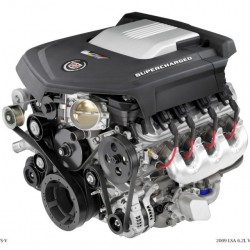What makes the CTS-V tick? LSA V-8 and transmission details
 Interested in seeing what makes the LSA V-8 tick? How about what transmissions can stand up to the fury of its supercharged power?
Check out the new LSA engine image gallery to see all sorts of technical bits that help the CTS-V make 550hp and make the competition quake with fear.
Then, read on for the official powertrain press release straight from Cadillac:
DETROIT – The all-new, 2009 Cadillac CTS-V blends exceptional performance with uncompromising refinement and its unique, 6.2L supercharged V-8 engine is, perhaps, the most dramatic example of the performance sedan’s world-class comportment.
Targeting 550 horsepower (410 kW) and 550 lb.-ft. of torque (745 Nm) – final SAE certified power levels will be available in early April 2008 – the CTS-V’s new LSA engine will be the most powerful ever offered in Cadillac’s nearly 106-year history. It is based on GM’s legendary small-block V-8 architecture and features an intercooled supercharger system, premium heat-resistant aluminum-alloy cylinder heads and numerous details designed to ensure the LSA makes its power as quietly and smoothly as possible.
“From the very start, engineers were cognizant of the role a high-performance engine plays in supporting the qualities customers expect in a Cadillac,” said Jim Taylor, Cadillac general manager. “The supercharged LSA engine delivers outstanding performance, but maximum power didn’t come at the expense of refinement or quietness.”
To achieve the desired balance between performance and drivability, the LSA was designed with numerous features and components that attenuate noise, including the supercharger. It has a new, four-lobe rotor design that enhances quietness while also optimizing the performance parameters of the engine.
A pair of six-speed transmissions is offered with the LSA: A new, Tremec TR6060 six-speed manual with a dual-disc clutch; and a Hydra-Matic 6L90 six-speed automatic with paddle-shift control – the first automatic offered in the CTS-V. Each transmission is designed to channel the engine’s tremendous power while simultaneously delivering exceptional refinement and smoothness.
Supercharged power and superior refinement
Delivering more than merely milestone power numbers, the LSA engine’s sixth-generation Eaton supercharger enables a broader range of power through the rpm band. This gives the engine great low-end torque and excellent horsepower at higher rpm – the range of the rpm band where a supercharger generally loses its effectiveness.
“The new design of the supercharger’s rotating internal components extends its effective range, giving the engine a wide, flat power band that is usable at all rpm levels,” said Ron Meegan, assistant chief engineer. “Whether at low speeds or on the highway, the
feeling of power is instant, strong and sustained.”
An intercooler mounted atop the engine sends the supercharger’s pressurized air through a heat exchanger to lower its temperature before entering the engine’s intake system. The cooler air is denser, helping the engine maximize performance.
Complementing the LSA’s tremendous output is a combination of components and design elements designed to ensure a quiet, refined driving experience. Examples include:
* Balanced, lightweight reciprocating assembly
* Hypereutectic pistons
* Lower-lift, low overlap camshaft
* Center-feed fuel system
* Acoustic engine cover
* Piston oil squirters
The new, four-lobe rotor design of the sixth-generation Eaton supercharger also contributes significantly to the LSA’s quiet performance. In fact, the quiet operation of the supercharger system fooled several onlookers during the CTS-V’s development – onlookers who were convinced that a prototype running at wide-open throttle on Germany’s famed Nürburgring racing circuit couldn’t possibly have a supercharger because there was no audible sound from the drive system.
“The characteristic whine of the supercharger is drastically reduced because of the LSA’s four-lobe rotor design,” said Meegan. “And with the other noise-reduction features used throughout, the sound is virtually eliminated.”
Transmission details
The new TR6060 transmission is based on the proven T56 six-speed used in the previous CTS-V, but upgraded to handle the LSA engine’s substantial increase in torque, as well as improve shift quality, via a dual-disc clutch system.
The twin-disc clutch delivers exceptional clamping power and excellent shift effort, achieved with the use of a pair of smaller-diameter clutch discs that have less inertia than a single, larger-diameter disc. Like the previous CTS-V, a dual-mass flywheel is used, which allows for smooth, chatter-free performance.
When it comes to the new automatic transmission, GM’s Hydra-Matic 6L90 six-speed automatic transmission features steering-wheel- and console-shifter-activated tap up/tap down gear control, as well as driver-selectable modes that deliver different performance characteristics, i.e. shift points, shift firmness, for different driving conditions. Performance Algorithm Shifting is part of the 6L90’s controller programming and provides a performance-oriented shift pattern during sustained high-performance driving, such as at a racetrack.
A twin-plate torque converter clutch is used with the 6L90 transmission to match the torque output of the LSA engine – the first twin-plate configuration used with GM’s 300-mm torque converter. Like the dual-disc clutch of the six-speed manual transmission, the twin-plate converter clutch provides exceptional clamping power.
New, Performance Traction Management technology works with the CTS-V’s engine and transmissions to optimize traction and maximize the performance driving experience.
Interested in seeing what makes the LSA V-8 tick? How about what transmissions can stand up to the fury of its supercharged power?
Check out the new LSA engine image gallery to see all sorts of technical bits that help the CTS-V make 550hp and make the competition quake with fear.
Then, read on for the official powertrain press release straight from Cadillac:
DETROIT – The all-new, 2009 Cadillac CTS-V blends exceptional performance with uncompromising refinement and its unique, 6.2L supercharged V-8 engine is, perhaps, the most dramatic example of the performance sedan’s world-class comportment.
Targeting 550 horsepower (410 kW) and 550 lb.-ft. of torque (745 Nm) – final SAE certified power levels will be available in early April 2008 – the CTS-V’s new LSA engine will be the most powerful ever offered in Cadillac’s nearly 106-year history. It is based on GM’s legendary small-block V-8 architecture and features an intercooled supercharger system, premium heat-resistant aluminum-alloy cylinder heads and numerous details designed to ensure the LSA makes its power as quietly and smoothly as possible.
“From the very start, engineers were cognizant of the role a high-performance engine plays in supporting the qualities customers expect in a Cadillac,” said Jim Taylor, Cadillac general manager. “The supercharged LSA engine delivers outstanding performance, but maximum power didn’t come at the expense of refinement or quietness.”
To achieve the desired balance between performance and drivability, the LSA was designed with numerous features and components that attenuate noise, including the supercharger. It has a new, four-lobe rotor design that enhances quietness while also optimizing the performance parameters of the engine.
A pair of six-speed transmissions is offered with the LSA: A new, Tremec TR6060 six-speed manual with a dual-disc clutch; and a Hydra-Matic 6L90 six-speed automatic with paddle-shift control – the first automatic offered in the CTS-V. Each transmission is designed to channel the engine’s tremendous power while simultaneously delivering exceptional refinement and smoothness.
Supercharged power and superior refinement
Delivering more than merely milestone power numbers, the LSA engine’s sixth-generation Eaton supercharger enables a broader range of power through the rpm band. This gives the engine great low-end torque and excellent horsepower at higher rpm – the range of the rpm band where a supercharger generally loses its effectiveness.
“The new design of the supercharger’s rotating internal components extends its effective range, giving the engine a wide, flat power band that is usable at all rpm levels,” said Ron Meegan, assistant chief engineer. “Whether at low speeds or on the highway, the
feeling of power is instant, strong and sustained.”
An intercooler mounted atop the engine sends the supercharger’s pressurized air through a heat exchanger to lower its temperature before entering the engine’s intake system. The cooler air is denser, helping the engine maximize performance.
Complementing the LSA’s tremendous output is a combination of components and design elements designed to ensure a quiet, refined driving experience. Examples include:
* Balanced, lightweight reciprocating assembly
* Hypereutectic pistons
* Lower-lift, low overlap camshaft
* Center-feed fuel system
* Acoustic engine cover
* Piston oil squirters
The new, four-lobe rotor design of the sixth-generation Eaton supercharger also contributes significantly to the LSA’s quiet performance. In fact, the quiet operation of the supercharger system fooled several onlookers during the CTS-V’s development – onlookers who were convinced that a prototype running at wide-open throttle on Germany’s famed Nürburgring racing circuit couldn’t possibly have a supercharger because there was no audible sound from the drive system.
“The characteristic whine of the supercharger is drastically reduced because of the LSA’s four-lobe rotor design,” said Meegan. “And with the other noise-reduction features used throughout, the sound is virtually eliminated.”
Transmission details
The new TR6060 transmission is based on the proven T56 six-speed used in the previous CTS-V, but upgraded to handle the LSA engine’s substantial increase in torque, as well as improve shift quality, via a dual-disc clutch system.
The twin-disc clutch delivers exceptional clamping power and excellent shift effort, achieved with the use of a pair of smaller-diameter clutch discs that have less inertia than a single, larger-diameter disc. Like the previous CTS-V, a dual-mass flywheel is used, which allows for smooth, chatter-free performance.
When it comes to the new automatic transmission, GM’s Hydra-Matic 6L90 six-speed automatic transmission features steering-wheel- and console-shifter-activated tap up/tap down gear control, as well as driver-selectable modes that deliver different performance characteristics, i.e. shift points, shift firmness, for different driving conditions. Performance Algorithm Shifting is part of the 6L90’s controller programming and provides a performance-oriented shift pattern during sustained high-performance driving, such as at a racetrack.
A twin-plate torque converter clutch is used with the 6L90 transmission to match the torque output of the LSA engine – the first twin-plate configuration used with GM’s 300-mm torque converter. Like the dual-disc clutch of the six-speed manual transmission, the twin-plate converter clutch provides exceptional clamping power.
New, Performance Traction Management technology works with the CTS-V’s engine and transmissions to optimize traction and maximize the performance driving experience.
